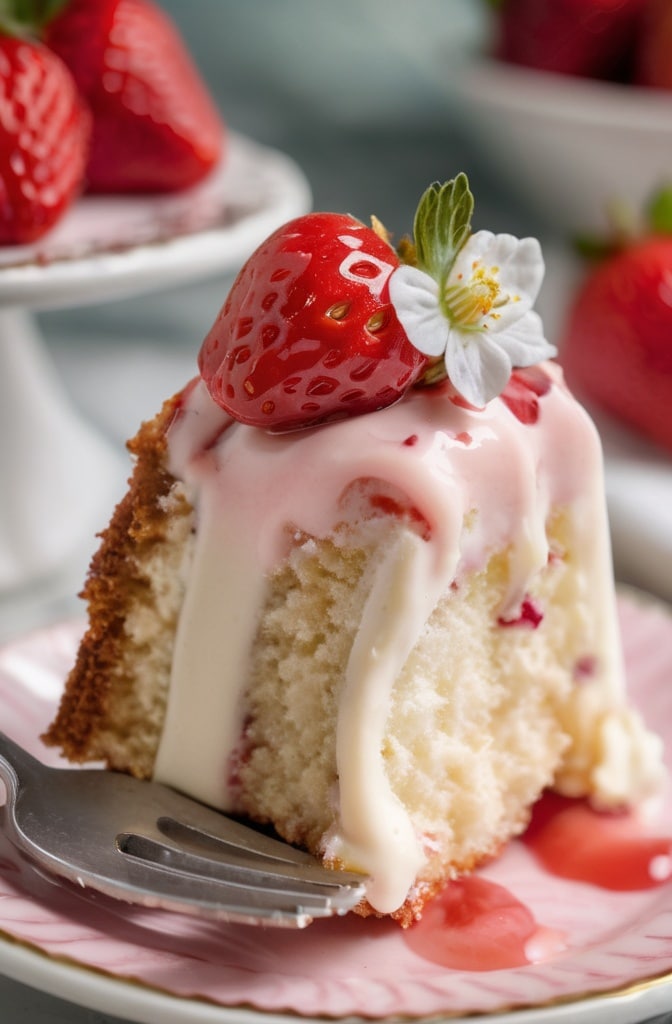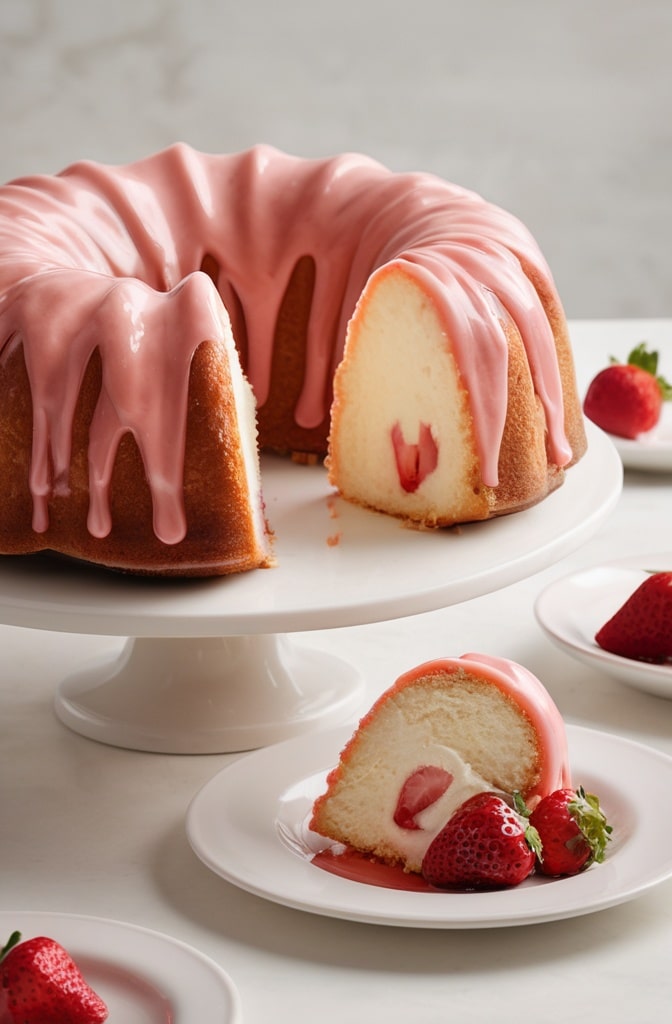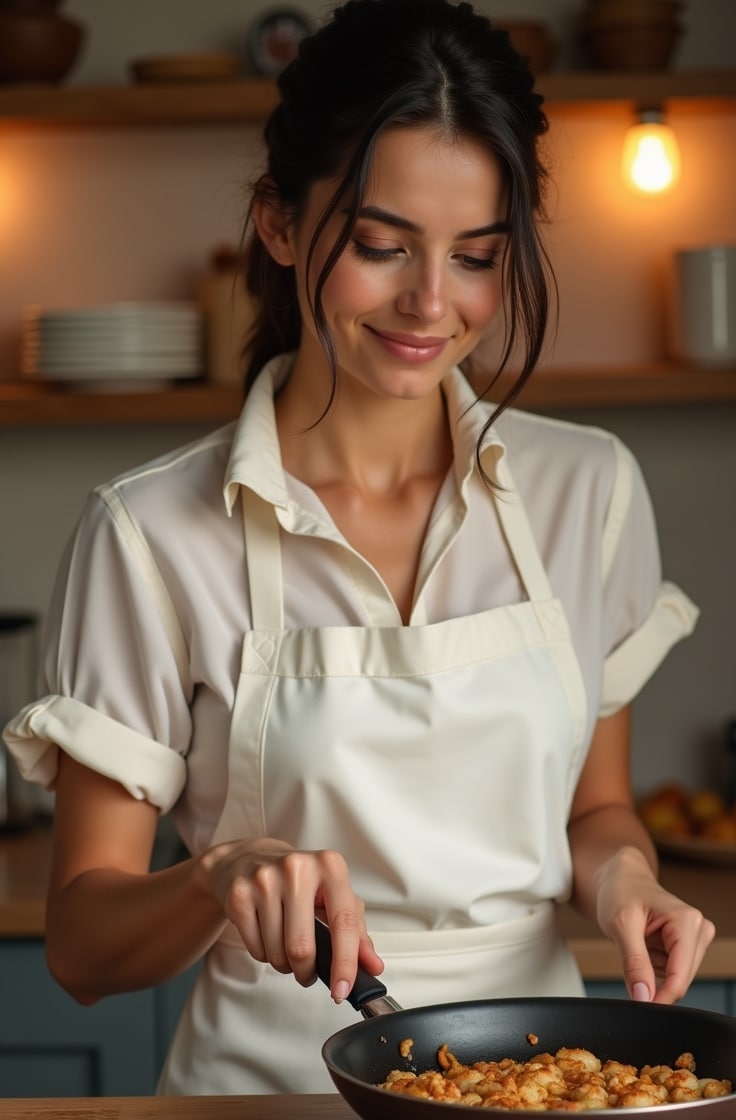I still remember the first time I pulled this Strawberry Cheesecake Bundt from my oven. The kitchen filled with an intoxicating aroma that transported me back to my grandmother’s farmhouse, where summer desserts weren’t just treats—they were celebrations. There’s somethin’ magical about combining the tartness of fresh strawberries with the rich decadence of cheesecake, all wrapped in the homey comfort of a beautifully baked bundt cake.
This recipe isn’t just another dessert. It’s what happens when classic cheesecake and traditional bundt cake have a delicious love child, creating a showstopper that delivers both impressive presentation and unforgettable flavor. The contrast between the dense, moist cake and pockets of creamy cheesecake studded with jammy strawberries creates textural magic few desserts can match.
Ingredients & Substitutions
For the Cream Cheese Filling:
- 16 oz (2 blocks) full-fat cream cheese, softened
- 2/3 cup granulated sugar
- 2 large eggs, room temperature
- 1 tsp pure vanilla extract
- 1/4 tsp almond extract (optional but recommended)
- 1 cup fresh strawberries, diced small
For the Cake Batter:
- 3 cups all-purpose flour
- 1 tsp baking powder
- 1/2 tsp baking soda
- 1 tsp salt
- 1 cup unsalted butter, softened (2 sticks)
- 2 cups granulated sugar
- 4 large eggs, room temperature
- 1 tbsp vanilla extract
- 1 cup full-fat sour cream
- 1 cup fresh strawberries, diced
For the Strawberry Glaze:
- 1 cup powdered sugar
- 2-3 tbsp strawberry puree (from about 1/4 cup fresh berries)
- 1/2 tsp lemon juice
- Pinch of salt
Low-fat cream cheese can work in a pinch, but you’ll sacrifice that luxurious mouthfeel that makes the cheesecake portion so divine. Neufchâtel cheese makes a reasonble substitute with about 1/3 less fat. For a dairy-free version, coconut cream can replace sour cream, tho you’ll get a slight coconut undertone that actually pairs beatifully with strawberries.
When strawberries aren’t in season, frozen berries can work for the filling and glaze—just thaw, drain well, and pat dry to avoid excess moisture. Raspberries or a mixed berry blend can create stunning flavor variations. The quality of your vanilla makes a remarkable difference here—Madagascar bourbon vanilla extract elevates this from good to transcendent.
Step-by-Step Instructions

Preparing the Filling:
- Beat softened cream cheese in a stand mixer with the paddle attachment until completely smooth, about 2 minutes. Scrape down the sides at least twice—lumps are the enemy of silky cheesecake! Many bakers rush this step, but patience here prevents those annoying little cheese lumps in your final product.
- Add sugar gradually while mixing on medium speed, then add eggs one at a time, incorporating fully between additions. Gently fold in the diced strawberries by hand using a spatula. Over-mixing after adding eggs can incorporate too much air and cause cracks, so go easy.
- Transfer filling to a piping bag or zip-top bag with corner snipped (no tip needed) and refrigerate while preparing the cake batter. Chilling the filling makes it easier to create that perfect tunnel of cheesecake goodness without it blending into the cake batter.
Making the Cake Batter:
- Preheat your oven to 325°F (165°C)—slightly lower than typical cake recipes because we’re aiming for a longer, gentler bake to keep everything moist. Generously grease and flour a 12-cup bundt pan, paying special attention to all the nooks and crannies. I’ve had many a beautiful cake ruined by inadequate pan prep—don’t skip this!
- Whisk together flour, baking powder, baking soda, and salt in a medium bowl. In your mixer bowl, cream butter and sugar until light and fluffy, about 4-5 minutes on medium-high speed. This isn’t just mixing—we’re creating microscopic air pockets that give the cake structure.
- Add eggs one at a time, mixing well after each addition, then add vanilla extract. Alternately add the dry ingredients and sour cream in three additions, beginning and ending with dry ingredients. Mix just until incorporated—overmixing develops gluten, which leads to a tough cake. Gently fold in the diced strawberries by hand.
Assembly and Baking:
- Pour half the cake batter into the prepared bundt pan, spreading evenly. Use a spoon to create a shallow channel in the center of the batter, going around the entire ring. Think of creating a little moat for your filling.
- Pipe the cream cheese filling into this channel, being careful to keep it away from the edges of the pan. Top with remaining cake batter, smoothing to cover the filling completely. Tap the pan firmly on the counter several times to eliminate air bubbles.
- Bake for 70-80 minutes, or until a wooden skewer inserted near the center comes out clean. If the top browns too quickly, tent loosely with aluminum foil. Cool in the pan for exactly 15 minutes (set a timer!), then invert onto a cooling rack. Too little cooling time and the cake will fall apart; too much and it’ll stick to the pan.
Creating the Glaze:
- For the glaze, blend fresh strawberries until smooth and strain to remove seeds. Mix powdered sugar with 2 tablespoons of the strawberry puree and lemon juice, adding more puree as needed to reach desired consistency. You want it thick enough to cling to the cake but thin enough to drizzle artfully.
- When the cake is completely cool (rushing this step will melt your glaze), place it on a serving plate and drizzle the glaze over the top, allowing it to naturally cascade down the ridges of the bundt. For a professional finish, catch excess glaze with parchment paper, then remove for clean presentation.
Cooking Techniques & Science
The magic of this cake lies in its contrasting textures—achieving that perfect balance requires understanding how the different components behave during baking. Cheesecake is essentially a custard, requiring gentle heat to set properly without curdling. By embedding it within the cake batter, we create insulation that allows it to cook more gradually.
That dense, velvety crumb we’re after comes from the cake’s high fat content and the acidity in both sour cream and strawberries. The acid tenderizes the gluten proteins, while the fat coats them, preventing tough strands from forming. This is why we fold in berries last—their weight and moisture would otherwise collapse those precious air bubbles we’ve worked to incorporate.
Many bundt cakes suffer from dryness, but our higher-than-usual ratio of sour cream creates exceptional moisture retention. The proteins in sour cream denature during baking, forming a network that traps water molecules. Meanwhile, the sugars in the berries undergo caramelization, creating those pockets of jammy delight throughout the cake.
Your bundt pan’s material significantly impacts baking dynamics. Dark, non-stick pans absorb heat more rapidly and produce more browning. If using one, reduce oven temperature by 25°F. Traditional aluminum pans distribute heat more evenly but require meticulous greasing—a paste of melted butter and flour applied with a pastry brush reaches every crevice.
Serving & Pairing Suggestions
This cake achieves peak magnificence about 4 hours after baking, when the flavors have fully melded but the textures remain distinct. Serve slices at room temperature for optimal flavor perception—cold temperatures mute the vanilla notes and strawberry brightness.
For an elevated presentation, garnish each slice with a quenelle of lightly whipped mascarpone cream, a few macerated strawberry slices, and a light dusting of freeze-dried strawberry powder. The vibrant pink powder against the white glaze creates visual drama that signals “special occasion” before the first bite.
This bundt pairs beautifully with afternoon tea—particularly a delicate white tea or a lightly oxidized oolong, whose floral notes complement the strawberry without overwhelming. For wine enthusiasts, a late-harvest Gewürztraminer or a strawberry-forward rosé prosecco creates a delightful harmony.
The cake keeps remarkably well for up to 3 days stored in an airtight container at room temperature. Refrigeration extends shelf life to 5 days but compromises texture slightly—a quick 10-second microwave zap restores much of the original mouthfeel. You can also freeze individual slices, well-wrapped, for up to 2 months; thaw overnight in the refrigerator.
For brunch service, try toasting slices lightly and serving with crème fraîche and a drizzle of aged balsamic—the subtle acidity balances the sweetness in an unexpectedly sophisticated way. When serving as a dessert course, a small pour of Chambord or strawberry liqueur alongside each slice creates an indulgent finish to a special meal.
Troubleshooting & Expert Tips
The most common pitfall with this recipe is moisture management. Too much liquid from the strawberries can create gummy streaks in your cake. After dicing berries, place them on paper towels for about 10 minutes to absorb excess juice. Don’t discard those precious juices—add them to your glaze for intensified flavor!
If your cream cheese filling sinks completely to the bottom (which becomes the top after inverting), it was likely too thin. Temperature matters enormously here—cream cheese should be softened but still cool to the touch, not warm and melty. The eggs, too, should be room temperature but not sitting out for hours.

The classic “tunnel of filling” effect requires proper batter consistency. If your batter seems unusually thick, add 1-2 tablespoons of milk. Too thin? Add another tablespoon of flour. The ideal consistency should slowly ribbon off the spatula and level out gradually when spread.
For professional-level flavor complexity, try browning the butter before adding it to the batter. The nutty, caramelized notes create a sophisticated backdrop that elevates the fresh strawberry flavor. Just be sure to chill the browned butter back to solid form before creaming with sugar.
Altitude adjustments are crucial above 3,500 feet: reduce sugar by 1 tablespoon per cup, increase flour by 1 tablespoon per cup, and add 1 extra tablespoon of liquid. Increase oven temperature by 25°F and reduce baking time by about 5-7 minutes.
Conclusion
This Strawberry Cheesecake Bundt Cake represents everything wonderful about scratch baking—the transformation of simple ingredients into something far greater than the sum of its parts. The interplay of textures and flavors creates a memorable dessert experience that feels simultaneously innovative and comfortingly familiar.
What makes this recipe truly special is its versatility across occasions. Elegant enough for formal gatherings yet homey enough for family celebrations, it bridges the gap between everyday baking and special-occasion showpieces. The technique of creating a cheesecake tunnel can be adapted to countless flavor combinations—imagine blueberry-lemon in spring or pumpkin-maple for autumn.
Remember that great baking is part science, part artistry, and part intuition. Once you’ve mastered this recipe, trust your instincts to make it your own. Maybe add a hint of basil to the strawberry glaze, or incorporate a streusel layer for textural contrast. The possibilities are as endless as your imagination.
FAQs About Strawberry Cheesecake Bundt
Can I make this cake ahead of time for a special event?
Absolutely! This cake actually develops deeper flavor complexity when made 1 day in advance. Prepare completely, including glaze, then cover loosely with a cake dome or overturned bowl. For events 2-3 days out, wait to add the glaze until a few hours before serving for the freshest appearance.
Why did my cream cheese filling leak out during baking?
This typically happens when the channel created for the filling isn’t deep enough or when the filling is too thin. Make sure your cream cheese is properly softened but not warm, and that your channel is at least 1 inch deep. Also check that your oven temperature is accurate—too low and the cake batter won’t set quickly enough to “trap” the filling.
Can I use a regular cake pan instead of a bundt pan?
While you technically could use two 9-inch round pans, the results won’t be nearly as impressive. The bundt design creates the ideal ratio of exterior to interior, allowing proper heat distribution for that perfect texture contrast. If you must use standard pans, reduce baking time by about 15-20 minutes and watch carefully.
My strawberries sank to the bottom of the cake—what went wrong?
Coating your diced strawberries in 1 tablespoon of the measured flour before folding them in helps prevent sinking. Also, make sure your berries are small dice (about 1/4 inch pieces) rather than larger chunks, which are more likely to sink during baking.
How can I intensify the strawberry flavor when using less-than-perfect berries?
Macerate half your berries in 1 tablespoon of sugar for 30 minutes, then drain (reserving juice) and mix with the fresh berries. The macerating process concentrates flavor. Add the reserved juice to your glaze for an extra flavor boost. You can also add 1/4 teaspoon of strawberry extract or 1 tablespoon of freeze-dried strawberry powder to the batter.

